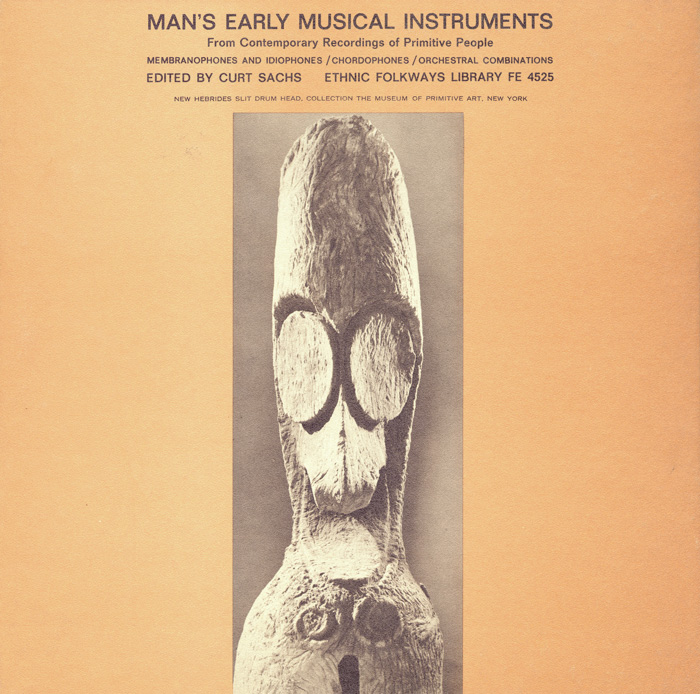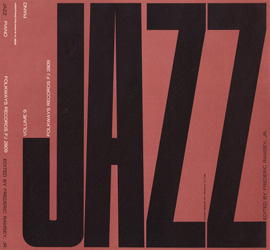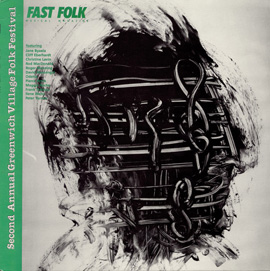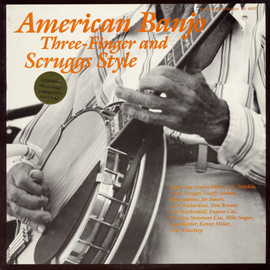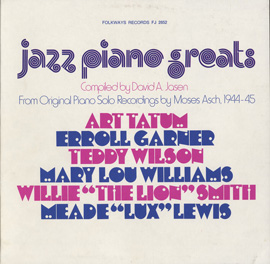Track Listing
|
101
|
Māori male singer and mixed chorus with drummer
|
00:35 | |
|
102
|
Vincente Escudero
|
00:35 | |
|
103
|
Group of Bulu women, Cameroon
|
00:44 | |
|
104
|
Group of Yolngu men and women, Australia
|
00:21 | |
|
105
|
Group of Hanunóo women playing kalutang (musical sticks), Philippines
|
00:31 | |
|
106
|
Krisnaswāmī Iyer
|
00:52 | |
|
107
|
Yawalapití men, ceremonial chant with rattles, Mato Grosso
|
00:41 | |
|
108
|
Musicians playing alghoza, ghara (clay pitcher), Pakistan
|
00:21 | |
|
109
|
Kamayurá men singing, playing rattles, Mato Grosso
|
00:31 | |
|
110
|
Male singer with guiro (scraper), Mexico
|
00:34 | |
|
111
|
Mbala chief, Democratic Republic of the Congo
|
00:55 | |
|
112
|
Quechua musicians playing tinya and quena, Quispicanchis
|
00:38 | |
|
113
|
Philip Broken Leg
|
00:46 | |
|
114
|
Polly, Atitah, Mikusha, and Billy Boy of Shugliaq, Nunavut
|
01:38 | |
|
115
|
Bukharian women with doyra accompaniment, Palestine
|
01:05 | |
|
116
|
Yoruba drummers at annual festival of Orisa-nla, Nigeria
|
01:52 | |
|
117
|
Petro drummers, Haiti
|
00:35 | |
|
118
|
D.K. Pattamal
|
02:03 | |
|
119
|
Pat waing player, Myanmar
|
01:28 | |
|
201
|
Gong ensemble, hne (oboe) player, male singer, Myanmar
|
01:59 | |
|
202
|
Hanunóo gong ensemble, Philippines
|
00:37 | |
|
203
|
Nōmanji Temple bell, Kawasaki, Japan
|
00:25 | |
|
204
|
Master Dattopant and Group
|
02:33 | |
|
205
|
Three Yasua balafon players, Ogooué River Region
|
01:34 | |
|
206
|
Bapindi men, Kikongo village, Western Congo
|
00:44 | |
|
207
|
Hanunóo kinaban player, Philippines
|
00:33 | |
|
208
|
Didjeridu puller with rhythm sticks, Australia
|
00:39 | |
|
209
|
Men playing antelope horn, iron bell, and mixed chorus, Democratic Republic of the Congo
|
00:31 | |
|
210
|
Male singer with ciaramella, zampogna, Caserta, Italy
|
01:22 | |
|
211
|
Shepherd piper with kanun accompaniment, Greece
|
01:15 | |
|
212
|
Barzani dozaleh player, Kurdistan
|
01:08 | |
|
213
|
Patrick J. Touhey
|
00:44 | |
|
214
|
Accordion player with percussionist, Chavantina, Brazil
|
01:02 | |
|
215
|
Kaval (flute) player, Macedonia
|
01:21 | |
|
216
|
Svirala (flute) player, Serbia
|
00:40 | |
|
217
|
Jerome Vanderburg
|
00:48 | |
|
218
|
Two Kamayurá men playing tarawi (double flute), Brazil
|
00:45 | |
|
219
|
Pierre Rochas
|
00:43 | |
|
220
|
Aymara pan-pipe orchestra, Lake Titicata region, Peru
|
01:04 | |
|
221
|
Temiar nose flute player recorded at Gerik, Malaysia
|
01:31 | |
|
301
|
Christophe Oxilas
|
00:47 | |
|
302
|
Mboko man playing musical bow, Cameroon
|
00:55 | |
|
303
|
U Ba Than
|
01:09 | |
|
304
|
Tzotzil harpist, Mexico
|
01:09 | |
|
305
|
Swami D. R. Parvatikar
|
01:36 | |
|
306
|
Group of Hanunóo children, Philippines
|
01:06 | |
|
307
|
Ruhenzi
|
01:14 | |
|
308
|
Lengleik player, Norway
|
01:08 | |
|
309
|
Masenqo player, Gura Valley, Eritrea
|
01:40 | |
|
310
|
Wolof géwël (griot) accompanying himself on xalam
|
01:20 | |
|
311
|
Two male singers accompanied by tambura, Montenegro
|
01:16 | |
|
312
|
Female singer with shamisen accompaniment, Okayama
|
02:00 | |
|
313
|
Dock Boggs
|
01:19 | |
|
314
|
Niño Ricardo and la Niña de los Peines
|
02:38 | |
|
315
|
Manolo de Badajoz
|
00:27 | |
|
316
|
Hanunóo boy, Philippines
|
01:13 | |
|
401
|
Guslar (singer) accompanying himself on gusle, Montenegro
|
01:15 | |
|
402
|
Musicians playing sarinda, flute, ghara (clay pitcher), Pakistan
|
01:38 | |
|
403
|
Musicians playing huqin, yangqin, China
|
01:25 | |
|
404
|
Tcherawata player, Gura Valley, Eritrea
|
01:05 | |
|
405
|
Folk singer Sadik, Black Sea region, Turkey
|
00:58 | |
|
406
|
Johannes Dale
|
01:20 | |
|
407
|
Georges Simon
|
01:35 | |
|
408
|
Gamelan orchestra, Koeta, Indonesia
|
02:57 | |
|
409
|
Sein Be Dar Orchestra
|
01:30 | |
|
410
|
Bang Khun Phrom Palace Orchestra
|
03:14 | |
|
411
|
String ensemble with violin, Romania
|
03:06 | |
|
412
|
Cobla ensemble, Catalonia
|
03:08 |


